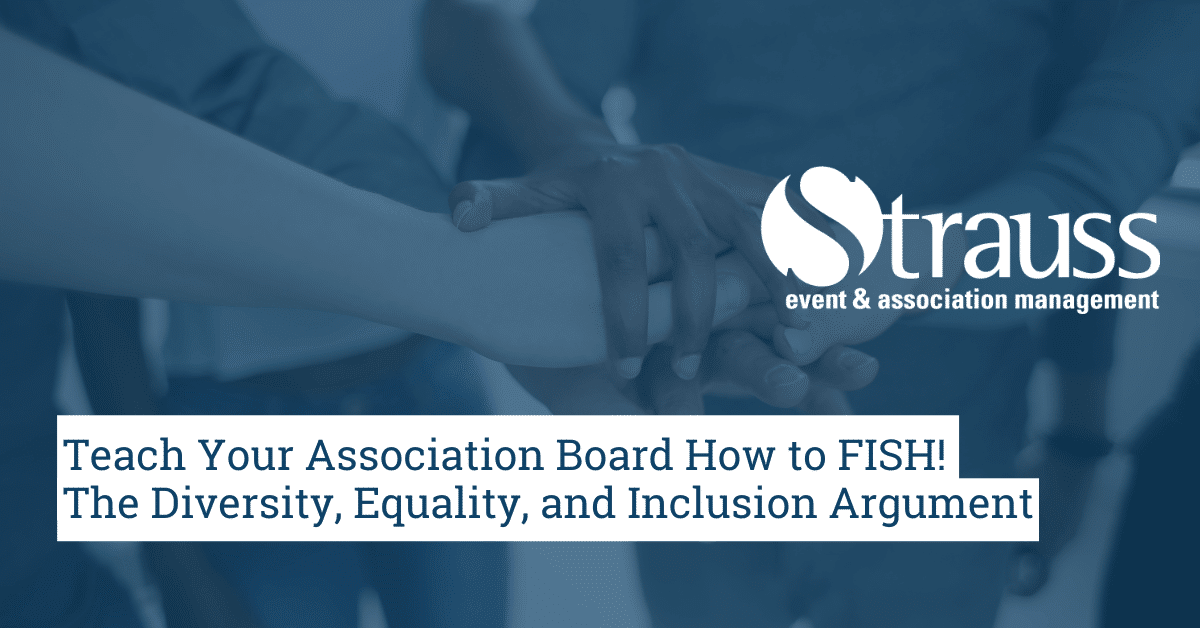I don’t fish as I have never had the patience to sit that long but I recently took part in an online training program that made me think of the following phrase: “Give a Man a Fish, and You Feed Him for a Day. Teach a Man To Fish, and You Feed Him for a Lifetime”
I would amend this phrase as follows to more inclusive in today’s day & age: Give a person a fish, and you feed them for a day. Teach them how to fish, and you feed them for a lifetime.
DEI for All to Learn
Diversity, equality, and inclusion (DEI) is top of mind for society, including associations and their members. Black Lives Matter, BIPOC, and gender equality are a sample of initiatives are present in society today, and there are many more. It is a hard topic for some to discuss, getting their heads around how decisions are made and how those decisions affect your association members.
I have sat through many discussions and training sessions related to DEI over the past few years and one thing that has always struck me about the discussions is the following:
- How do we start incorporating DEI into policies and decisions?
- How do we avoid taking a stand that might offend a group of individuals?
- We are inclusive already, aren’t we?
The list is WAY longer than the few points I mentioned. Incorporating DEI is complex and most – if not all – boards need guidance discussing it and creating action plans to recognize and act on DEI initiatives within their associations. Many associations / organizations reach out to consultants to walk them through training exercises related to DEI. This approach works well for some groups but might not be feasible for all based on the cost of hiring a consultant.
Where to Learn About DEI?
One of my board chairs and I interviewed a few organizations on how they might help the association and their board work through DEI. How can decisions be made and how that might impact DEI?
An example of a policy that should be looked at through the DEI lens is how an association deals with maternity leaves and maintaining continuing education points (CEP’s) for certification. Is it fair to ask parents (maternity/ paternity) to maintain CEP’s during the child-bearing years at the same level as regular members?
Tidal Equality was recommended we meet for a conversation about their approach to DEI. After meeting with one of the co-founders, we decided to do their online training program which talked about the “Equity Sequence.” I cannot go into the detail of the “Equity Sequence” as it is trademarked, but they did give me permission to share what I got out of it.
A Great Way to Gain New Perspectives
One of the challenges I have seen with many of my association clients over the years is how they grapple with decisions and discussions about DEI when typically, there isn’t a ton of diversity around the board table. An “Equity Sequence” session brings participants together to learn how to expand equity in organizational decision-making by asking a series of powerful equity-focused and strategic questions – without judgement, and with curiosity & respect.
A few board members and I did the online “Equity Sequence” training course that walked us through the “Equity Sequence” series of questions. This helped us think of equity when looking at various scenarios that occur within our associations. The training had a series of videos explaining the “Equity Sequence” and then provided an opportunity to apply what we learned. After each module, the questions tested our understanding of the module and sequence. It gave us an opportunity to apply what we had learned.
The valuable piece for me was the community that Tidal Equality have created. Participants taking the training could share what they learned with other participants but also learn from others involved in the program. Powerful stuff!
Making Your Association Event More Inclusive is a great article that looks at inclusivity through an event planning lens.
Teach a Person to Fish
The fishing analogy applies as the “Equity Sequence” teaches its participants to look at the various policies/activities/events they put on and filter it through the series of questions. If you follow the questions, your outcome will be more equitable in nature. Rather than having a consultant come in and tell you what you need to do, the “Equity Sequence” gives you the tools to ask the appropriate series of questions to determine the right course of action for your group.
The board members that took the online training have recommended the training for the entire board. This will allow the entire board to talk through the “Equity Sequence” when looking at developing or creating policies for board & members. The online program took under three hours to complete and provided some takeaway material and was reasonably priced.
The “Equity Sequence” online training program is worth putting a “Gone Fishing” auto reply on your email for a few hours!
Read Diversity in the Association Boardroom to learn more about the importance of different perspectives around the board table.

